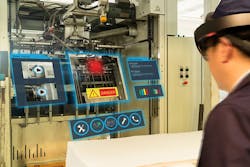According to Google Trends data, automation remains a controversial topic. “Are robots taking over jobs” is peaking at a similar search volume as ten years ago — but a new concept is changing the role of automation in the workplace. Here, Mark Howard, US country manager at industrial parts supplier, EU Automation, explains how augmented intelligence could assist with human and machine collaboration.
Augmented intelligence is one of the few technologies named on the Gartner Hype Cycle for Emerging Technologies, 2019 that are predicted to reach expectations, over the next two-to-five years. In contrast to artificial intelligence (AI), augmented intelligence emphasises collaborations between AI and human workers. It’s designed to enhance human skills and allow them to work faster and more efficiently, rather than replace them.
Admittedly, augmented intelligence doesn’t resemble the “mechanical muscle” that many workers typically associate as being a threat to jobs — like powerful Selective Compliance Articulated Robot Arms (SCARA), for instance. But, let’s be realistic, human workers will never compete with the speed and accuracy of a SCARA robot when assigned to complete a pick-and-place process. Nor can they match the power of a six-axis machine for loading and unloading applications.
However, many workers today also feel threatened by machines that can make decisions — often more efficiently than humans do.
AI is already being used to meet quality regulations and standards in manufacturing. Coined as Quality 4.0, the concept involves the use of AI algorithms to recognize emerging production faults that have the potential to cause problems in product quality. Subtle abnormalities in machine behaviour, deterioration of equipment or changes to raw materials can all be intelligently identified. This allows AI to make automatic changes to production, if necessary.
Once instance might be if an automated conveyor is left on standby until it’s required for the transportation of a batch. The system can send an automated command to turn on the machine at the exact moment it’s required. Furthermore, working with an industrial parts supplier can ensure that this connectivity is seamless. The supplier can provide a list of parts manufacturers to choose from, and ensure easy integration with the AI system in question.
That said, while advanced AI can fix some issues automatically, the process is not always devoid of human intervention. Other issues, such as emergency maintenance of a machine, will always require human involvement at some stage. AI can provide the alert, but it can’t always do the work.
So, what’s the difference between AI and augmented intelligence? Arguably, there is not much too it.
It could be argued that augmented intelligence is simply an alternative label for the way AI is currently used in industry. AI is not presently advanced enough to operate entirely without human workers’ help. Even lights-out manufacturing facilities — automated factories that operate without human workers on the floor — will require human interference at some stage during the process; whether that’s for programming, maintenance or any decision making that goes beyond data analysis.
As Google Trends data suggests, workers still fear the threat that automation poses to jobs. To alleviate this apprehension, manufacturers should adopt alternative approaches to scaremongering concepts like AI, such as augmented intelligence. The technology may have been named as an emerging trend in the Gartner Hype Cycle, but it could be argued that manufacturers are already using this methodology to enhance their operations. It’s still AI, but with a little human involvement.
We’re already aware of the benefits manufacturers can reap by investing in automation. Focussing on human-centric terminology, like augmented intelligence, will ensure that workers are not ostracized during their employers’ inevitable transition to smart manufacturing.
About the Author
Mark Howard, EU Automation
U.S. Country Manager
Mark Howard is the U.S. country manager for EU Automation, an automation parts supplier. Contact him at [email protected].
